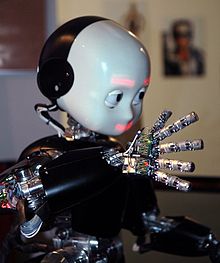Science and technology in Italy
The Romans developed new techniques and used materials such as volcanic soil from Pozzuoli, a village near Naples, to make their cement harder and stronger.
Leonardo da Vinci, was trained to be a painter, but his interests and achievements spread into an astonishing variety of fields that are now considered scientific specialties.
Notably, he invented concepts for the helicopter, an armed fighting vehicle, the use of concentrated solar power, the calculator, a rudimentary theory of plate tectonics, the double hull, and many others, using inspiration from Chinese ideas.
[12] In addition, he greatly advanced the fields of knowledge in anatomy, astronomy, civil engineering, optics, and hydrodynamics.
Giuseppe Peano, Lagrange, Fibonacci, and Gerolamo Cardano, whose Ars Magna is generally recognized as the first modern treatment on mathematics, made fundamental advances to the field.
Physicist Enrico Fermi, a Nobel prize laureate, led the team in Chicago that developed the first nuclear reactor.
[17] Other physicists include Amedeo Avogadro (contributions to molecular theory), Evangelista Torricelli (inventor of the barometer), Alessandro Volta (inventor of the electric battery), Guglielmo Marconi (inventor of radio), Galileo Ferraris and Antonio Pacinotti (pioneers of the induction motor), Alessandro Cruto (pioneer of the light bulb), and Innocenzo Manzetti (pioneer of automatons and robotics), Ettore Majorana (discovered Majorana fermions), Carlo Rubbia (1984 Nobel Prize in physics), and Antonio Meucci (developing voice-communication device sometimes credited as the first telephone).
Founded in the Papal States in 1603 by Federico Cesi, the academy was named after the lynx, an animal whose sharp vision symbolizes the observational prowess that science requires.
[33] Laboratori Nazionali del Gran Sasso (LNGS) is the largest underground research center in the world.
[37] The primary mission of the laboratory is to host experiments that require a low background environment in the fields of astroparticle physics and nuclear astrophysics and other disciplines that can profit of its characteristics and of its infrastructures.
The consortium is also strongly committed to transfer technology to many categories of users, from public administration to the private enterprises.
Today it merges the specificities and competences of the other two Italian high performance computing consortia, CILEA and Caspur: as a unique reference point for technology innovation in Italy, with its services Cineca supports the whole higher education and research system.
Internationally, the ASI provides Italy's delegation to the Council of the European Space Agency and to its subordinate bodies as well as representing the country's interests in foreign collaborations.
During the Renaissance Italian polymaths such as Leonardo da Vinci (1452–1519), Michelangelo (1475–1564) and Leon Battista Alberti (1404–1472) made contributions in a variety of fields, including biology, architecture, and engineering.
Galileo Galilei (1564–1642), an astronomer, physicist, engineer, and polymath, played a major role in the Scientific Revolution.
In mathematics, Joseph Louis Lagrange (born Giuseppe Lodovico Lagrangia, 1736–1813) was active before leaving Italy.
Physicist Enrico Fermi (1901–1954), a Nobel prize laureate, led the team in Chicago that developed the first nuclear reactor.
[16] He, Emilio G. Segrè (1905–1989) who discovered the elements technetium and astatine, and the antiproton), Bruno Rossi (1905–1993) a pioneer in Cosmic Rays and X-ray astronomy) and a number of Italian physicists were forced to leave Italy in the 1930s by Fascist laws against Jews.
[69] Other prominent physicists include Amedeo Avogadro (most noted for his contributions to molecular theory, in particular the Avogadro's law and the Avogadro constant), Evangelista Torricelli (inventor of barometer), Alessandro Volta (inventor of electric battery), Guglielmo Marconi (inventor of radio), Galileo Ferraris and Antonio Pacinotti, pioneers of the induction motor, Alessandro Cruto, pioneer of light bulb and Innocenzo Manzetti, eclectic pioneer of auto and robotics, Ettore Majorana (who discovered the Majorana fermions), Carlo Rubbia (1984 Nobel Prize in Physics for work leading to the discovery of the W and Z particles at CERN).
[72][73][74] In biology, Francesco Redi has been the first to challenge the theory of spontaneous generation by demonstrating that maggots come from eggs of flies and he described 180 parasites in details and Marcello Malpighi founded microscopic anatomy, Lazzaro Spallanzani conducted research in bodily functions, animal reproduction, and cellular theory, Camillo Golgi, whose many achievements include the discovery of the Golgi complex, paved the way to the acceptance of the Neuron doctrine, Rita Levi-Montalcini discovered the nerve growth factor (awarded 1986 Nobel Prize in Physiology or Medicine).
Italian people – living in the Italic peninsula or abroad – have been throughout history[76] the source of important inventions and innovations in the fields of writing,[77][78] calendar,[79] mechanical[80] and civil engineering,[81][82][83][84] musical notation,[85] celestial observation,[86] perspective,[87] warfare,[88][89][90][91] long distance communication,[92][93][94] storage[95] and production[96][97] of energy, modern medicine,[98] polymerization[99][100] and information technology.
[101][102] Italians also contributed in theorizing civil law,[103][104] scientific method (particularly in the fields of physics and astronomy),[105] double-entry bookkeeping,[106] mathematical algebra[107] and analysis,[108][109] classical and celestial mechanics.








